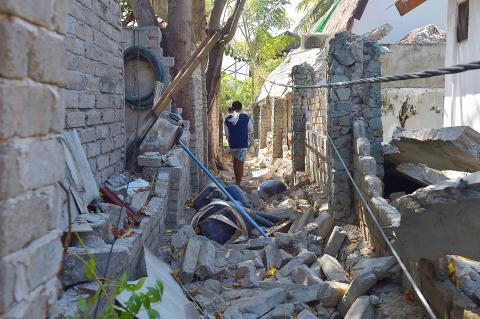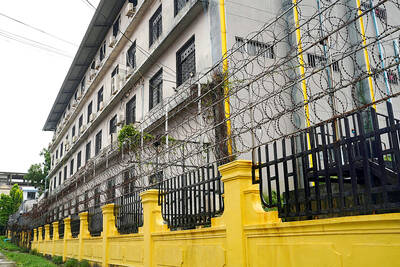Scientists say the powerful Indonesian earthquake that killed nearly 400 people lifted the island it struck by as much as 25cm.
The Indonesian National Disaster Mitigation Agency yesterday said that 387 people died, jumping from the 321 it reported the previous day, as search and rescue teams continued to sift through the rubble and people already buried by relatives are accounted for.
Using satellite images of Lombok from the days following the Aug. 5 quake, scientists from NASA and the California Institute of Technology’s joint rapid-imaging project made a ground deformation map and measured changes in the island’s surface.

Photo: AFP
In the northwest of the island near the epicenter, the rupturing faultline lifted the earth by a quarter of a meter. In other places it dropped by 5cm to 15cm.
NASA said satellite observations can help authorities respond to earthquakes and other natural or human-caused disasters.
Almost 390,000 people, about 10 percent of Lombok’s population, are homeless or displaced after the earthquake, which damaged and destroyed about 68,000 homes.
Disaster agency spokesman Sutopo Purwo Nugroho said three districts in the north of Lombok still have not received any assistance.
The governor of West Nusa Tenggara Province, which includes Lombok, has extended the official emergency period by two weeks to Aug. 25.
“It’s estimated the death toll will continue to grow, because there are still victims who are suspected of being buried by landslides and collapsed buildings, and there are deaths that have not been recorded,” Nugroho said.
The number of evacuees fluctuates, because not all evacuee points have been counted and some people tend to their gardens and properties during the day and return to the tent camps at night, he said. Some people do not need to evacuate, because their homes are not damaged, but they have come to refugee centers because they feel traumatized.
Nearly a week after the magnitude 7 quake, Lombok is still reeling, but glimmers of normality were returning for some and villagers are making plans for temporary replacements of mosques that were flattened.

Drug lord Jose Adolfo Macias Villamar, alias “Fito,” was Ecuador’s most-wanted fugitive before his arrest on Wednesday, more than a year after he escaped prison from where he commanded the country’s leading criminal gang. The former taxi driver turned crime boss became the prime target of law enforcement early last year after escaping from a prison in the southwestern port of Guayaquil. Ecuadoran President Daniel Noboa’s government released “wanted” posters with images of his face and offered US$1 million for information leading to his capture. In a country plagued by crime, members of Fito’s gang, Los Choneros, have responded with violence, using car

Canada and the EU on Monday signed a defense and security pact as the transatlantic partners seek to better confront Russia, with worries over Washington’s reliability under US President Donald Trump. The deal was announced after a summit in Brussels between Canadian Prime Minister Mark Carney and European Commission President Ursula von der Leyen and European Council President Antonio Costa. “While NATO remains the cornerstone of our collective defense, this partnership will allow us to strengthen our preparedness ... to invest more and to invest smarter,” Costa told a news conference. “It opens new opportunities for companies on both sides of the

The team behind the long-awaited Vera Rubin Observatory in Chile yesterday published their first images, revealing breathtaking views of star-forming regions as well as distant galaxies. More than two decades in the making, the giant US-funded telescope sits perched at the summit of Cerro Pachon in central Chile, where dark skies and dry air provide ideal conditions for observing the cosmos. One of the debut images is a composite of 678 exposures taken over just seven hours, capturing the Trifid Nebula and the Lagoon Nebula — both several thousand light-years from Earth — glowing in vivid pinks against orange-red backdrops. The new image

CYBERCRIME, TRAFFICKING: A ‘pattern of state failures’ allowed the billion-dollar industry to flourish, including failures to investigate human rights abuses, it said Human rights group Amnesty International yesterday accused Cambodia’s government of “deliberately ignoring” abuses by cybercrime gangs that have trafficked people from across the world, including children, into slavery at brutal scam compounds. The London-based group said in a report that it had identified 53 scam centers and dozens more suspected sites across the country, including in the Southeast Asian nation’s capital, Phnom Penh. The prison-like compounds were ringed by high fences with razor wire, guarded by armed men and staffed by trafficking victims forced to defraud people across the globe, with those inside subjected to punishments including shocks from electric batons, confinement